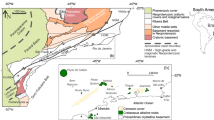Abstract
A comparison of mantle xenolith suites along the northern Canadian Cordillera reveals that the xenoliths from three suites exhibit bimodal populations whereas the xenoliths from the other four suites display unimodal populations. The bimodal suites contain both fertile lherzolite and refractory harzburgite, while the unimodal suites are dominated by fertile lherzolite xenoliths. The location of the three bimodal xenolith suites correlates with a newly discovered P-wave slowness anomaly in the upper mantle that is 200 km in width and extends to depths of 400–500 km (Frederiksen AW, Bostock MG, Van Decar JC, Cassidy J, submitted to Tectonophysics). This correlation suggests that the bimodal xenolith suites may either contain fragments of the anomalously hot asthenospheric mantle or that the lithospheric upper mantle has been affected by the anomalously hot mantle. The lherzolite xenoliths in the bimodal suites display similar major element compositions and trace element patterns to the lherzolite xenoliths in the unimodal suites, suggesting that the lherzolites represent the regional lithospheric upper mantle. In contrast, the harzburgite xenoliths are highly depleted in terms of major element composition, but their clinopyroxenes [Cpx] have much higher incompatible trace element contents than those in the lherzolite xenoliths. The major element and mildly incompatible trace element systematics of the harzburgite and lherzolite xenoliths indicate that they could be related by a partial melting process. The lack of textural and geochemical evidence for the former existence of garnet argues against the harzburgite xenoliths representing actual fragments of the deeper anomalous asthenospheric mantle. Furthermore, the calculated P-wave velocity difference between harzburgite and lherzolite end-members is only 0.8%, with the harzburgites having higher P-wave velocities. Therefore the 3% P-wave velocity difference detected teleseismically cannot be produced by the compositional difference between the lherzolite and harzburgite xenoliths. If temperature is responsible for the observed 3% P-wave velocity perturbation, the anomalous mantle is likely to be at least 200 °C higher than the surrounding mantle. Taken together these data indicate that the refractory harzburgite xenoliths represent the residue of 20–25% partial melting of a lherzolite lithospheric mantle. The incompatible trace element enrichment of the harzburgites suggests that this melting was accompanied by the ingress of fluids. The association of the bimodal xenolith suites with the mantle anomaly detected teleseismically suggests that anomalously hot asthenospheric mantle provided both the heat and volatiles responsible for the localized melting and enrichment of the lithospheric mantle.
Similar content being viewed by others
Author information
Authors and Affiliations
Additional information
Received: 16 May 1997 / Accepted: 25 October 1997
Rights and permissions
About this article
Cite this article
Shi, L., Francis, D., Ludden, J. et al. Xenolith evidence for lithospheric melting above anomalously hot mantle under the northern Canadian Cordillera. Contrib Mineral Petrol 131, 39–53 (1998). https://doi.org/10.1007/s004100050377
Issue Date:
DOI: https://doi.org/10.1007/s004100050377




